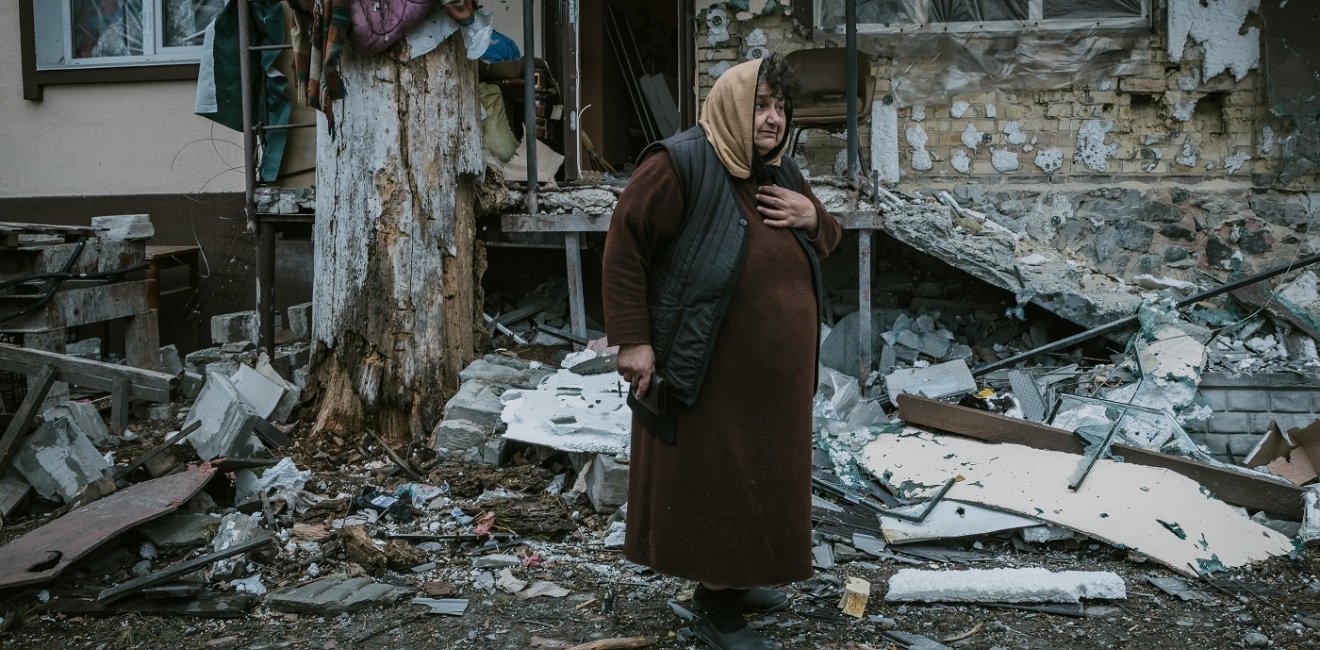
A blog of the Kennan Institute
BY KATERINA SERGATSKOVA
Since February, Russia has been attacking Ukrainian cities from different directions with different weapons. Tens of thousands of people have died because of this attack. How is the invasion affecting people in these areas, and what challenges do they face in everyday life? Here are a few insights into the living conditions of Ukrainian citizens in war zones, from a reporter who regularly travels to regions neighboring the Russian army.
Since the Russian army fled Kyiv and Chernihiv and regrouped in Donbas and the south, the situation has changed for residents of frontline towns.
The largest cities of the Donetsk region have found themselves in the immediate zone of military action. For example, Sloviansk, one of the largest cities in the region, is now about 20 kilometers from Russian army positions. On a daily basis, the city and its outskirts are shelled with rockets, heavy long-range artillery, and Grad multiple rocket launchers. Unlike in other regions of Ukraine, where warnings of possible shelling are only activated at specific times, the air raid siren runs day and night. The sound has become background noise for residents. Until a month ago, Sloviansk had markets where locals sold vegetables and meat from their farms and could somehow earn a living. But the front line moved even closer to the city, and several markets were destroyed by rocket fire.
Tens of thousands of people, many of them children and the elderly, remain in Donbas. All of them are forced to live under constant shelling, hiding in basements and bomb shelters. They obtain food from volunteers and warehouses where humanitarian aid is distributed. Most of them have no means of livelihood left.
In the south, in the Mykolaiv and Kherson regions, Russia has created many domestic problems.
It blocked the Kherson Oblast water passage in April. For a whole month, there was no water in Mykolaiv and its suburbs at all. Then the local authorities were able to organize water from another source, the Southern Bug. The water in it is salty and dirty, so they had to spend a lot of effort to create a filtration system, and still, there is not enough to completely purify the water. From residents’ taps, brackish water flows, and day by day, this water eats away at the pipes. Citizens are forced to stand in lines for free drinking water. Every day in Mykolaiv, volunteers pour water at 11 points organized by volunteers of the local Red Cross. According to Arkady Dabagyan, the deputy head of the Red Cross, every day they pump out about 120,000 liters of pure water, which is often not enough. According to the mayor's office, about 250,000 residents remain in the city—half the prewar population.
Mykolaiv is a frontline city. Russian troops are located about 20 kilometers from it, in the occupied territories of the Kherson region. Locals can count the days when the city has not been shelled. They have had only 21 days of silence in the nearly six months since the invasion began. Russia shells Mykolaiv every day with rockets, long-range artillery, and cluster munitions. Most often, they hit civilian infrastructure and residential areas. In late July, cluster shells hit a bus stop and killed four people. Before that, the Russians hit two universities, two hotels, community centers, and a water distribution point. Local authorities call these attacks terrorism because they do not make any military sense.
The Amnesty International published a report on August 3 in which it criticized the Ukrainian military for putting civilians at risk by locating near residential areas. The report sparked a major international discussion, which led the organization to issue an apology. AI researchers concluded that the Russian army selects targets in Ukrainian cities based on military location data. For example, if the army made an out-of-operation school its temporary base, it was very likely that a Russian missile would fly into the school and the surrounding area. According to AI, the military shouldn’t be in the cities at all because it “endangers civilians.”
But mostly Russia shells targets that are not military and have nothing related to the military around them. For instance, on March 16, Russia bombed the Mariupol drama theater, which served as a shelter for hundreds of residents. On June 27, it bombed a shopping mall in Kremenchuk with hundreds of customers inside. It is not clear how the Russian army chooses its targets, but there is an understanding among people who live in Ukraine that tomorrow the rocket launched from Russia, Belarus, or occupied territories may kill any of them.
In the frontline cities, locals are generally aware that if there is a military headquarters or some war-related service area near their home, they are at increased risk of attack. War does not take place in the fields; it takes place in cities, the method that Russia has chosen for attacking Ukraine.
An important question is how evacuation from war zones is organized. At the very beginning of the invasion, hundreds of thousands of Ukrainians and foreigners left Ukraine on their own. Later, as the military attacks shifted to the east and south, the evacuation process was set up in a systemic way. The key artery for evacuation was the railroad from Pokrovsk (a small town in the western Donetsk region) to Dnipro and Lviv. And the transportation of people who decided to leave via the railway station fell mostly on the shoulders of public organizations, from local volunteer initiatives to the Red Cross. In the south, the railroad does not work, so people are transported by buses and cars.
Despite the terrible shelling, many locals in both the south and the Donbas do not want to leave their homes, even though they realize that they may die in the next attack. One of the key reasons is that they have nowhere to go. Many left at the beginning of the invasion for safer cities in Ukraine or Europe, but returned because they had spent all their savings on temporary housing. In Ukraine, there are still no special places to move to for longer periods, and temporary evacuation sites often involve living in overcrowded barracks with mattresses on the floor. Free food is not always adequate. This makes it difficult for families with children and the elderly.
Meanwhile, in most EU countries, as well as in the U.S. and Canada, where millions of Ukrainians have poured in, there is no room for refugees. European countries are already overcrowded. Governments and local communities cannot respond to all requests, and they are unlikely to be able to cope with a likely new wave of refugees.
In late July, Ukrainian President Vladimir Zelensky announced the mandatory evacuation of residents of the Donetsk region. Every citizen is supposed to leave the frontline zone and sign a document in which they confirm their intention. In this case, local administrations help with the evacuation. Citizens can remain in their homes, but all the related risks will fall on them personally.
One of the reasons the Ukrainian government launched mandatory evacuations is the problems with getting ready for winter in advance. In Donbas, most homes already have no gas, there is a problem with electricity, and there is a lack of coal in the country. Local authorities are urging citizens who have wood-burning stoves to stock up on firewood. Cold weather will be another big challenge for residents of Ukraine, in addition to the ongoing attacks from Russia. And for some people, this particular challenge could prove fatal.
The opinions expressed in this article are those solely of the author and do not reflect the views of the Kennan Institute.
Author


Kennan Institute
The Kennan Institute is the premier US center for advanced research on Eurasia and the oldest and largest regional program at the Woodrow Wilson International Center for Scholars. The Kennan Institute is committed to improving American understanding of Russia, Ukraine, Central Asia, the South Caucasus, and the surrounding region through research and exchange. Read more

Explore More in Focus Ukraine
Browse Focus Ukraine
Talking to the Dead to Heal the Living

Ukrainian Issue in Polish Elections


